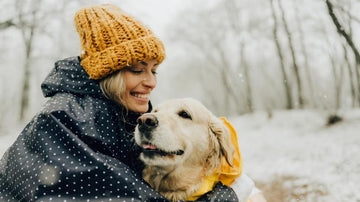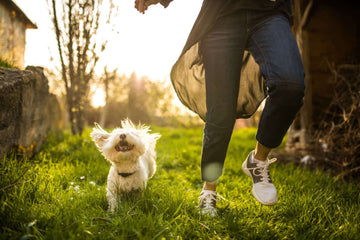As the weather begins to cool down, it’s time to start thinking about how the cold affects your dog. While some dogs are built to withstand chilly temperatures, others are more sensitive to the cold. Ensuring your dog is comfortable and safe in cold weather is crucial for their health and well-being. Whether your pup is full of energy and loves the outdoors or prefers to snuggle up inside, this guide will help you keep them warm and healthy throughout the winter months.
Can Dogs Get Cold?
Yes, just like humans, dogs can get cold. Even though dogs have fur coats, they aren’t always enough to protect them from freezing temperatures. Breeds with thicker, double coats like Siberian Huskies, Newfoundlands, and Golden Retrievers are more adapted to cold climates, while smaller or thin-coated dogs like Chihuahuas and Greyhounds can feel cold more quickly.
Several factors determine how easily a dog gets cold:
- Size: Smaller dogs lose heat faster than larger dogs due to their larger surface area relative to their size.
- Coat type: Dogs with thick, double-layered coats tend to stay warmer than those with thin or short fur.
- Body weight: Dogs with more body fat retain heat better than lean dogs.
- Age and health: Puppies, older dogs, and dogs with medical conditions (like arthritis) get cold quicker.
When a dog is exposed to cold weather for too long, they may develop hypothermia, which is a life-threatening condition. To prevent this, pet owners must recognize the signs of cold in their dogs.
Signs That Your Dog is Cold
Fortunately, dogs will often let you know when they are uncomfortable in cold weather. Here are some common signs that your dog is feeling cold:
- Shivering or trembling
- Whining or crying
- Lifting their paws off the ground to avoid cold surfaces
- Tucking their tail or hunching up
- Showing reluctance to move or walk
- Seeking warmth, like snuggling up close to you or lying in blankets
- Acting disoriented or confused
If your dog is showing these signs and you don’t bring them to a warmer place, they could develop hypothermia. Signs of hypothermia in dogs include:
- Weakness or lethargy
- Decreased mental awareness
- Shallow or slow breathing
- Loss of consciousness
If you notice these symptoms, act quickly to warm your dog and seek veterinary care immediately.
How Long Can a Dog Stay Outside in Winter?
There’s no one-size-fits-all answer to how long a dog can safely stay outside in winter. It depends on the temperature, weather conditions, and the individual dog. However, a good rule of thumb is: if you’re cold, your dog is cold.
- Above 40°F: Most dogs can stay outside comfortably for a while. However, smaller dogs or those with thin coats may still feel cold.
- 30°F – 40°F: Dogs with thicker coats may still be okay, but smaller or short-haired dogs may need a sweater. Keep an eye on your dog for signs of discomfort.
- 20°F – 30°F: It’s starting to get very cold for most dogs. At this point, you’ll need to limit their time outside, and consider using sweaters and boots to keep them warm.
- Below 20°F: Most dogs, even those bred for colder climates, should not spend extended periods outside. Cold weather gear is a must, and trips outside should be limited to bathroom breaks and brief exercise.
Keep in mind that factors like wind chill and wet conditions can make it feel much colder than the actual temperature. Also, if your dog is sitting still rather than playing or running, they’ll get cold more quickly.
How to Keep Your Dog Warm in Cold Weather
There are several ways to keep your dog warm and cozy during the winter, both indoors and outdoors. Here are some practical tips to help your pup stay toasty all season long:
1. Dress Your Dog for the Weather
Sweaters, jackets, and booties aren’t just for fashion; they provide extra warmth for your dog. Breeds with thin or short coats benefit the most from warm clothing, but even dogs with thicker fur can use a little extra help on very cold days. When choosing a jacket or sweater for your dog, make sure it fits snugly but isn’t too tight. There should be no dangling strings or buttons that your dog could chew on.
Booties are also a good idea for protecting your dog’s paws from snow, ice, and harmful chemicals like ice melt. Introduce booties gradually to give your dog time to adjust to wearing them.
2. Provide a Warm Sleeping Area
When temperatures drop, make sure your dog has a warm, draft-free place to sleep. Heated dog beds or beds designed to reflect body heat are great options. If your dog sleeps outside or in a garage, make sure they have an insulated shelter. Elevated beds or thick bedding can help keep your dog off cold floors and provide extra warmth. Adding blankets or cushions to their sleeping area will help them snuggle in and stay cozy.
3. Groom Your Dog Regularly
Proper grooming is essential during the winter months. While you might be tempted to let your dog’s fur grow long to keep them warm, regular grooming prevents mats and tangles that can make your dog uncomfortable. Matted fur doesn’t insulate well, and wet, dirty fur can lead to skin issues. If your dog spends time outdoors, be sure to dry them off thoroughly after coming inside.
If you bathe your dog during the winter, use warm water and make sure they are completely dry before letting them back outside. Cold, wet fur will cause them to lose heat quickly.
4. Adjust Your Dog’s Diet
Dogs burn more calories in the winter to stay warm, especially if they’re active outdoors. You may need to increase your dog’s food intake slightly to meet their increased energy needs. However, if your dog is less active in winter, be cautious of overfeeding, as this can lead to weight gain. Consult your veterinarian for advice on adjusting your dog’s diet during the colder months.
5. Keep Fresh Water Available
It’s easy to forget that dogs need access to water in winter just as much as they do in the summer. If your dog spends time outside, make sure their water bowl doesn’t freeze. Heated water bowls are a good option for preventing freezing, and always provide fresh, clean water indoors as well.
6. Limit Outdoor Time
Even the hardiest dogs shouldn’t spend long periods outside in freezing temperatures. When you take your dog outside, make sure they’re moving and active to help generate body heat. Keep trips outside short, and always bring your dog inside if they show signs of discomfort or cold.
7. Watch for Signs of Frostbite
Frostbite can affect a dog’s ears, paws, and tail when exposed to extreme cold. Signs of frostbite include pale or gray skin, swelling, and pain when touched. If you suspect frostbite, gradually warm the affected areas with warm water and seek veterinary care as soon as possible.
8. Emergency Preparedness
Winter storms and power outages can create challenging situations for keeping your dog warm. If you lose power, share body heat by snuggling up with your dog, and provide extra blankets or sweaters. Hand warmers can also be placed in blankets to help your dog stay warm (just ensure they can’t chew on them). In case of a natural disaster or evacuation, always take your pets with you to a safe shelter.
Winter weather brings new challenges for dog owners, but with the right precautions, you can keep your dog warm, safe, and healthy all season long. Pay attention to your dog’s individual needs, and don’t be afraid to break out the cozy sweaters and heated beds when temperatures drop. Remember, if you’re cold, your dog is probably cold too. By following these tips, you can ensure your furry friend stays comfortable and happy during the chilly winter months.




